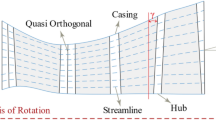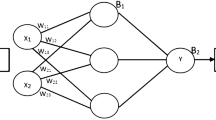Abstract
Recent work has shown that deep learning provides an alternative solution as an efficient function approximation technique for airfoil surrogate modeling. In this paper we present the feasibility of convolutional neural network (CNN) techniques for aerodynamic performance evaluation. CNN approach will enable designer to fully utilize the ability of computers and statistics to interrogate and interpolate the nonlinear relationship between shapes and flow quantities, and rapidly perform a thorough optimization of the wide design space. The principal idea behind the current effort is to uncover the latent constructs and underlying cross-sectional relationships among the shape parameters, categories of flow field features, and quantities of interest in turbo-machinery blade design. The proposed CNN method is proved to automatically detect essential features and effectively estimate the pressure loss and deviation much faster than CFD solver.
Access this chapter
Tax calculation will be finalised at checkout
Purchases are for personal use only
Similar content being viewed by others
References
Anderson, G.: R and Aftosmis. Adaptive shape parameterization for aerodynamic design. Nat. Aeronaut, Michael J (2015)
Ando, K., Takamura, A., Saito, I.: Automotive aerodynamic design exploration employing new optimization methodology based on CFD. SAE Int. J. Passenger Cars-Mech. Syst. 3, 398–406 (2010)
Cho, S.-Y., Yoon, E.-S., Choi, B.-S.: A Study on an axial-type 2-D turbine blade shape for reducing the blade profile loss. KSME Int. J. 16(8), 1154–1164 (2002)
Rai, M.M., Madavan, N.K.: Aerodynamic design using neural networks. AIAA J. 38(1), 173–182 (2000)
Rai, M.M., Madavan, N.K.: Application of artificial neural networks to the design of turbomachinery airfoils. J. Propul. Power 17(1), 176–183 (2001)
Papila, N., Shyy, W., Griffin, L., Dorney, D: Shape optimization of supersonic turbines using response surface and neural network methods. In: 39th Aerospace Sciences Meeting and Exhibit 1065 (2016)
Zhang, Y., Sung, W.J., Mavris, D.N.: Application of convolutional neural network to predict airfoil lift coefficient. In: 2018 AIAA/ASCE/AHS/ASC Structures, Structural Dynamics, and Materials Conference 1903 (2018)
Bhatnagar, S., Afshar, Y., Pan, S., Duraisamy, K., Kaushik, S.: Prediction of aerodynamic flow fields using convolutional neural networks. Comput. Mech. 64(2), 525–545 (2019)
Wu, H., Liu, X., An, W., Chen, S., Lyu, H.: A deep learning approach for efficiently and accurately evaluating the flow field of supercritical airfoils. Comput. Fluidsr. 198(2), 104393 (2020)
Thuerey, N., Weißenow, K., Prantl, L., Hu, X.: Deep learning methods for Reynolds-averaged Navier-Stokes simulations of airfoil flows. AIAA J. 58(1), 25–36 (2020)
Wang, C., Gao, Z., Huang, J., Zhao, K., Li, J.: Smoothing methods based on coordinate transformation in a linear space and application in airfoil aerodynamic design optimization. Sci. China Technol. Sci. 58(2), 297–306 (2015)
Lassila, T., Rozza, G.: Parametric free-form shape design with PDE models and reduced basis method. Comput. Methods Appl. Mech. Eng. 199(23–24), 1583–1592 (2010)
Antunes, A.P., Azevedo, J.L.F.: Studies in aerodynamic optimization based on genetic algorithm. J. Aircraft. 51(3), 1002–1012 (2014)
Ariyarit, A., Kanazaki, M.: Multi-fidelity multi-objective efficient global optimization applied to airfoil design problems. Appl. Sci. 712, 1318 (2017)
Siddappaji, K.: Parametric 3d blade geometry modeling tool for turbomachinery systemss. University of Cincinnati (2012)
Guo, X., Li, W., Iorio, F.: Convolutional neural networks for steady flow approximations. In: Proceedings of the 22nd ACM SIGKDD International Conference on Knowledge Discovery and Data Mining, pp. 481–490 (2016)
Liu, X., Zhu, Q., Lu, H.: Modeling multiresponse surfaces for airfoil design with multiple-output-Gaussian-process regression. J. Aircraft. 513, 740–747 (2014)
Hollom, J., Qin, N.: Robustness of natural laminar flow airfoil drag optimization to transition amplification factor. In: 18th AIAA/ISSMO Multidisciplinary Analysis and Optimization Conference, p. 3144 (2017)
Simonyan, K., Zisserman, A.: Very deep convolutional networks for large-scale image recognition. J. Aircraft (2014). arXiv preprint: arXiv:1409.1556
Selvaraju, R.R., Cogswell, M., Das, A., Vedantam, R., Parikh, D., Batra, D.: Grad-cam: visual explanations from deep networks via gradient-based localization. In: Proceedings of the IEEE International Conference on Computer Vision, pp. 618–626 (2017)
Acknowledgments
This work utilizes resources supported by the National Science Foundation’s Major Research Instrumentation program, grant #1725729, as well as the University of Illinois at Urbana-Champaign.
Author information
Authors and Affiliations
Corresponding author
Editor information
Editors and Affiliations
Rights and permissions
Copyright information
© 2021 Springer Nature Switzerland AG
About this paper
Cite this paper
Luo, S., Cui, J., Sella, V., Liu, J., Koric, S., Kindratenko, V. (2021). Turbomachinery Blade Surrogate Modeling Using Deep Learning. In: Jagode, H., Anzt, H., Ltaief, H., Luszczek, P. (eds) High Performance Computing. ISC High Performance 2021. Lecture Notes in Computer Science(), vol 12761. Springer, Cham. https://doi.org/10.1007/978-3-030-90539-2_6
Download citation
DOI: https://doi.org/10.1007/978-3-030-90539-2_6
Published:
Publisher Name: Springer, Cham
Print ISBN: 978-3-030-90538-5
Online ISBN: 978-3-030-90539-2
eBook Packages: Computer ScienceComputer Science (R0)




